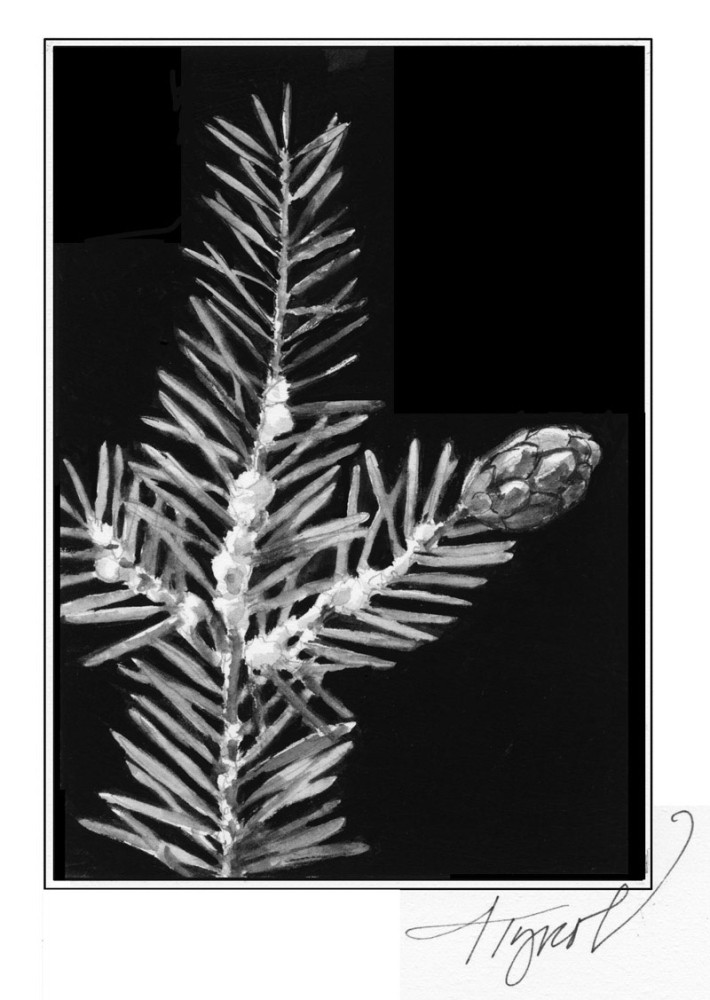
Cold got you down? Ready to trade in your hat and scarf for something a little scantier? While you’re waiting for that to happen – and good luck! – consider a visitor to these climes who is suffering even more than you are, a visitor that, with any luck, will be deeply harmed by this winter’s icy blast: the hemlock woolly adelgid.
The adelgid is a bug that’s hard to see and even harder to pronounce. It’s a close relative of the aphid, only about a millimeter in size for much of its life cycle, and pronounced “ah-del-jid.” It’s wreaked havoc on millions of acres of forest along the east coast of North America since being introduced by accident from Asia in the 1920s. In the last decade, it has arrived at the southern limits of New Hampshire and Vermont.
Where, potentially, the very thing that’s been driving some people crazy recently – the harsh winter – may prove to be its Waterloo. Or at least its high-water mark.
The adelgid, unlike most insects hereabouts, native or exotic, is active in winter. From October until February, the juveniles feed on the tender shoots of eastern hemlock trees. Because they are out and about in the winter, the adelgids, in theory at least, are more vulnerable to deep cold than insects that overwinter as eggs, in cocoons, or with some sort of winterizing antifreeze in their cells.
The theory hasn’t been tested much in the past few years. The lowest temperatures in much of New Hampshire and Vermont in 2008 and 2009 were ten or twenty degrees warmer than the usual low temperatures, giving the adelgids something of a free ride. But 2010-2011 has been a return to climatic form.
At present, the known outbreaks of hemlock woolly adelgid are confined to just six towns in Vermont, all in Windham County, and in four counties in New Hampshire: Cheshire, Hillsbrough, Merrimack, and Rockingham. The insect is spread primarily by birds moving from tree to tree, carrying hitchhiking adelgids along for the ride. Twenty miles per year was the average northward spread of the infestation in the mid-Atlantic states, though the rate has now slowed to less than 8 miles per year as the insects have encountered colder winters.
The wildcard has been the transportation of infected nursery stock, which can allow adelgids to advance many hundreds of miles at a time. Infected hemlocks turned up seven years ago in White River Junction, Vermont, at a nursery supply store, delivering adelgids into the center of the twin states. But concerted efforts by officials on both sides of the Connecticut tracked down nearly every tree sold by the nursery. There is a quarantine in both states that controls the movement of hemlocks to try to prevent a similar leapfrog in the future.
Farther south, the adelgids have killed hemlock trees across broad expanses of Connecticut and Pennsylvania, with expanding damage in Massachusetts. Healthy hemlocks can hang on for about ten years following an infestation. Trees already weakened by drought or pollution or some other stress can succumb in just three to four years.
The stakes in this battle are particularly high in New Hampshire and Vermont, and not just because our forests are still reeling from chestnut blight, butternut canker, and Dutch elm disease. Hemlock is a critical species for the winter survival of whitetail deer, which both browse its twigs and bed underneath it where the snow is less deep and the cold less intense. White pine and cedar can substitute for hemlock in some areas, as can spruce and fir in the northern reaches of the states, but no other tree is so important for deer over so broad an area. The whitetail is a supremely adaptable species, so it’s unlikely that the disappearance of hemlock from our forests would lead to the complete disappearance of deer, but there’s no doubt that the winter ecology of our northern forests would be severely disturbed.
As February progresses, the surviving adult hemlock woolly adelgids will cease their winter feeding and settle down to lay eggs on the undersides of hemlock needles. They will encase the tiny eggs in cotton-like sacs that are quite easy to see, clumped together where needles met branches. In other words, now is the best chance to scout the woods for this invader.
So before you hang up your hat and scarf in disgust, consider joining the corps of citizen volunteers who help wildlife officials in both states monitor the spread of the adelgid. If you flip over a hemlock branch and see the dreaded cottony egg sacs, contact UNH Cooperative Extension in New Hampshire or the Department of Forests, Parks, and Recreation in Vermont. With any luck, you won’t. Thanks to the harsh winter.


Discussion *